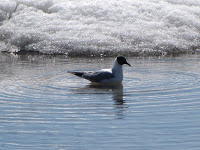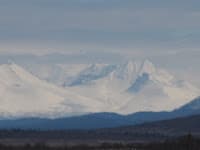Of course there was the obligatory first day paperwork yesterday. This took up half the morning. After lunch we drove the gravel back roads to start our familiarization with Katmai NP. 
About 3 miles from town on the far reaches of the paved Alaska Peninsula Highway (total length about 20 miles, from King Salmon to Naknek) we stopped at Float Plane Row. Looking shabby and forlorn, it was still closed down for the winter and wouldn’t open up for the summer season until June 1. From here, local boats would set out on the Naknek River for near-shore Bristol Bay waters in search of a good catch of salmon or herring, and commercial float planes would take eager clients to remote camps or wilderness lodges in hopes of catching a big trophy fish.
Rapids Camp is just inside the western boundary of the park.  Here is a small bay where water and shore birds have congregated to wait for the ice to melt so they could continue their northward summer migration. We saw tundra swans, Bonaparte’s gulls, and Greater Yellowlegs. Our swan expert happily talked about arctic terns, mergansers, and bald eagles as we stood and watched the icy waters teeming with life.
Here is a small bay where water and shore birds have congregated to wait for the ice to melt so they could continue their northward summer migration. We saw tundra swans, Bonaparte’s gulls, and Greater Yellowlegs. Our swan expert happily talked about arctic terns, mergansers, and bald eagles as we stood and watched the icy waters teeming with life.


We drove on, stopping to nibble on last year’s cranberries at Pike Ridge, a terminal moraine deposit of unsorted silt, pebbles, gravel, and small boulders. The moraine defines the farthest reaches of the last glacier to have occurred in this area. We were also driving through the most southwesterly edge of the spruce forest on the Alaskan peninsula. To my Utah eye it looked burned somehow, or overgrazed, with its sparse scrub cover and small scattered trees. We were driving across “wet tundra.” I asked about permafrost, and was told that there is some in this area, even though we are so far south, but that it is found only in small scattered patches in the more remote parts of Katmai. From this vantage Katmai National Park filled our field of view.


At Lake Camp we saw 3 bald eagles floating lazily overhead. A pile of swan feathers were gathered around a utility pole near the water’s edge.



The day was well spent, I thought. Geology, biology, and botany describing so many sizes, shapes, ages and life zones were given equal importance as a part of the orientation to the place where I will live for the next 5 months.






